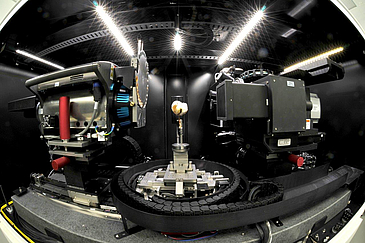“The project, which is possible due to this, forms the foundations for the creation of a core facility, which will be an important undertaking for the University of Bremen in the next years,” says the university president, Professor Bernd Scholz-Reiter. “The DFG approval shows that we have gone down the right path with our concept for the creation of a large core facility in order to strengthen the joint usage of scientific devices across disciplines.”
Expensive Analysis Equipment is Essential
Special, often expensive, analysis equipment is essential for research into and development of new materials, for example for applications in the field of sustainable mobility and energy. Six professors from various natural and engineering science disciplines want to make material analysis and the required investments more efficient and transparent. Alongside a better utilization of equipment, the combining of complementary analysis techniques would simplify the working steps and provide opportunities to analyze the same material samples in the same location using different methods.
Unique Combination of High-End Equipment
Five fields of analysis are to be combined under the roof of the MAPEX core facility: electron microscopy, 3D material analysis, surface analysis, ray diffraction, and spectroscopy. The high-end devices that are involved in such areas will form a unique combination that is nearly impossible to find at any other university. Thus, Bremen will become more attractive for external researchers and the usage of the available resources will be made more accessible.
“With the establishment of the core facility, new scientific cooperations will be supported and the knowledge transfer from and to the private economic and to the public will be strengthened,” says Professor Lucio Colombi Ciacchi, initiative coordinator, happily. It is in this way that the facility will contribute to the advancement of the region outside the university walls. “An important part of the project comprises activities that will add to the students’ education and transport the fascination of the world of materials to school pupils and interested members of the public,” explains Dr. Hanna Lührs, MAPEX scientific manager.
Focus: Materials and their Surfaces
The scientific focus of the planned core facility lies on the investigation of structural, topographical, and chemical changes in materials and their surfaces during their synthesis, manufacturing, and usage. The scientists responsible for the equipment will develop protocols for high-throughput analyses, in order to allow for a large number of samples to be analyzed in a short amount of time and with a high level of automation. Additionally, in-situ and real-time studies of material changes are to be carried out under varying environmental conditions, especially over large temperature ranges and in chemically aggressive surroundings.
Alongside Professor Colombi Ciacchi (production technology), the following persons are involved the project: Professor Jens Falta (physics), Professor Thorsten Gesing (chemistry), Professor Andreas Lüttge (geosciences), Professor Axel Herrmann (production technology), and Professor Andreas Rosenauer (physics).
Further Information:
https://www.dfg.de/en/research_funding/programmes/infrastructure/scientific_instrumentation/funding_opportunities/core_facilities/index.html
https://www.uni-bremen.de/en/mapex/
www.uni-bremen.de/en/
Contact:
Dr. Hanna Lührs and Prof. Lucio Colombi Ciacchi
MAPEX Center for Materials and Processes
University of Bremen
Phone: +49 (0)421 218-64580
Email: mapexprotect me ?!uni-bremenprotect me ?!.de

